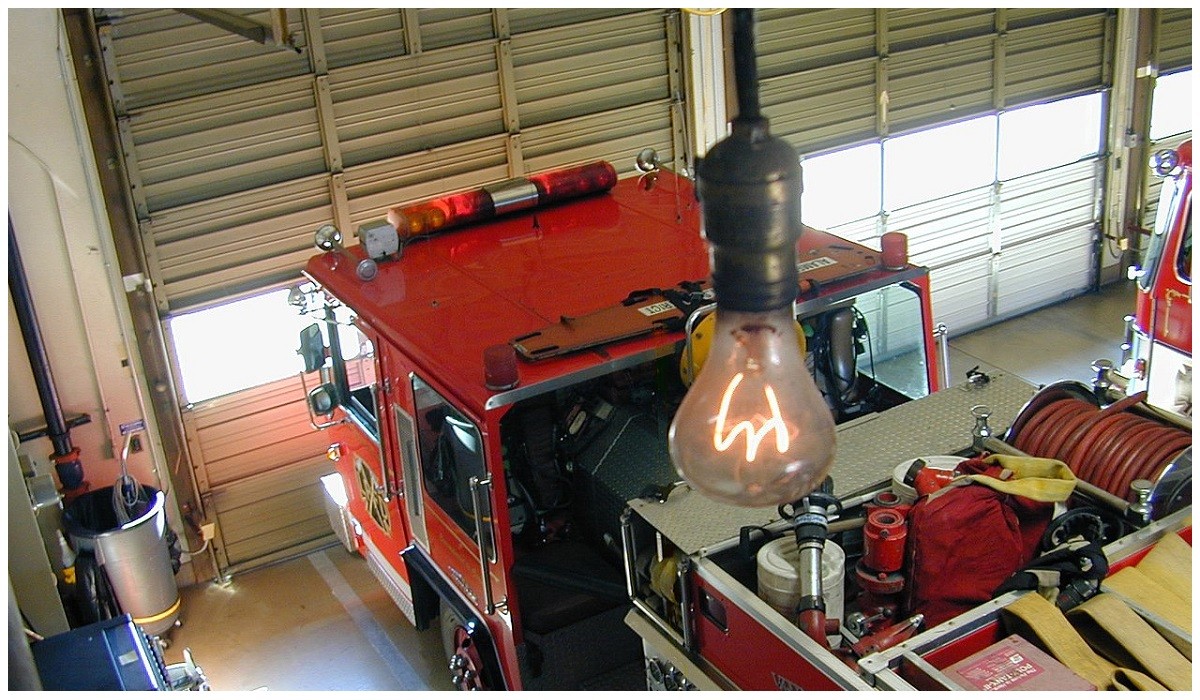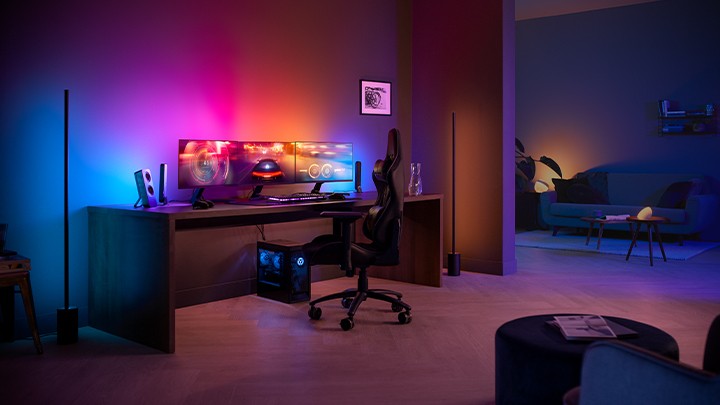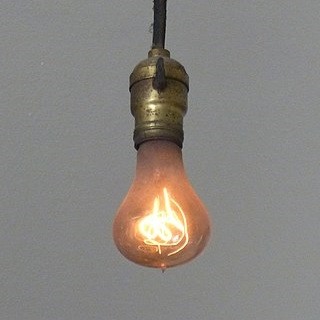Summarize
- The short life of incandescent light bulbs is due to commercial reasons and cartels
- Centennial Light has been burning in California for over 115 years
- LED technology is more energy efficient and more durable than incandescent lamps
- The Phoebus cartel reduced the lifetime of light bulbs to increase sales
- LED lighting has taken the market by storm, but sustainability problems persist
Why are light bulbs not made to last? Light bulbs last only 1 000 hours, washing machines 5 years, televisions 5 years… Things are no longer built to last. Why? For commercial reasons. It is very bad business to make products that last a long time, because what do manufacturers sell? I had heard somewhere that there was a 100-year-old light bulb burning in the world, so I looked into it further.
Eternal lamp
In Livermore, California, there’s a famous fire department that has had a light bulb burning in its garage for a hundred and fifteen years (115!) that won’t burn out. Instead, it gradually “ages” as the yarn burns. The day the light goes out is eagerly awaited. The lamp has been lit continuously (moved a couple of times) since 1901. That means that the lamp has already logged over 1 MILLION hours of use (2001)! The lamp was entered into the Guinness Book of World Records in 2015.
The “Centennial Light” was originally a 60 watt incandescent lamp, but today it is the equivalent of a 4 watt bulb, as the carbon filament in the lamp has gradually become obsolete. The lamp is hand-blown glass.
The ordinary incandescent lamp with carbon filament was invented by French engineer Adolphe Chaillet, who applied for a patent for this technology. The Shelby Electric Company manufactured it in Shelby, Ohio in the late 1890s and there are still many similar lamps around the world that still work. The fire station received the lamp as a donation in 1901 and it has been burning ever since.
The lamp differs from today’s incandescent lamp in its carbon filament, as the latest lamps use tungsten.
Centennial Light FACTS
– Hand-blown glass
– Carbon filament
– Originally 60W lamp, now 4W
– Burned for over a million hours (2001)
– Located in Livermore, USA
Today, any fan can monitor the lamp online with a webcam. Live pictures and interesting facts on the lamp’s own website: https://www.centennialbulb.org/

Led revolution
Why does no one make a light bulb when it could last so long? This issue has been studied and the Finnish magazine Suomen kuvalzeitung 2011 also identified the biggest problem with incandescent light bulbs. Its efficiency is miserable, only 5% is light and the remaining 95% is heat. So even if the bulb itself lasts, it is no match for current technology such as Led, which produces 15-30% of the energy it uses.
The Led was actually invented as early as 1907 and the first commercial version was available in the 1960s. Led is a light source based on semiconductor technology. At first, the LED was still very low-powered and only available in red, but in the 1990s they surpassed incandescent bulbs in efficiency.
Led has taken over the market for good in the late 2010s, when halogen was finally banned in Europe on 1.9.2018 and incandescent lamps were banned earlier on 1.9.2011. Now in the 2020s, we are in a situation where it is not uncommon to see LED luminaires on the market that are promised 50,000 hours or more and a light quality of a staggering CRI98.
Consumers and businesses have therefore made a big shift to LED technology over the last 10 years. This would seem to be a good thing, in terms of the environment and energy consumption, but making the lamps sustainable is proving to be a tricky problem: no one seems to have a sensible business model for such a product. It’s crazy, because this longevity was supposed to fix the biggest problem with incandescent light bulbs: short life.
The dark side of light
The 1,000-hour life of modern incandescent light bulbs dates back to 1924, when representatives of the world’s biggest lighting companies – including familiar names like Philips, Osram and General Electric (which took over Shelby Electric around 1912!) – gathered in Switzerland to form Phoebus, probably the first global cartel. More on the topic here

By that time, the life of the lamps had grown so long (over 2500 hours!) that they were causing a drop in sales turnover. So one of Phoebus’ priorities was to reduce lamp life to the standard of 1,000 hours.
Phoebus members justified the shorter life as an attempt to create a quality standard for brighter and more energy-efficient lamps. Markus Krajewski, who studied the Phoebus data, published a study in 2014 in which he concluded that the only significant technical innovation in the lamps was a sharp reduction in lifetime. It seems that the cartel’s explicit aim was to shorten the life of light bulbs in order to increase sales. For the benefit of economics, not physics.
The Phoebus cartel came to an end during the Second World War, when the collapse of the world economy radically changed the way it operated.
This cartel is now regarded as the first example of deliberate obsolescence in the industry. Nowadays, similar situations have occurred in the 2000s, the biggest being Apple’s deliberate slowing down of older phones in 2020 to get consumers to switch to a new phone faster.
Phoebus is easy to cast as a conspiracy of corporate malfeasors. However, planned ageing is in line with the views of economists and businessmen who believe that it is bad business to sell any product to a person only once. This sales model became so popular with the business community that it gave rise to the new consumer-driven economy. In 1928, a timeless statement was madein“American Prosperity: Its Causes and Consequences , Evolution of Distribution” (pages 24 and 25) by
Paul Mazur, Lehman Brothers: “Any community that lives on staples has relatively few wants. The community that can be trained to desire change, to want new things even before the old have been completely consumed, yields a market to be measured more by desires than by needs. And man”™s desires can be developed so that they will greatly overshadow his needs.”
and “We must teach consumers to want new things before the old ones are worn out.”
LEDs took over the world
But does the growing popularity of LEDs mean that we are moving towards a sustainable consumer economy? Hardly, but this is a step in the right direction. An environmentally conscious consumer will choose an LED luminaire that is not a cheap, loose bulb but a LED luminaire with a fair cooling element. These can be serviced if necessary.
The lighting industry is now at a turning point, which is already visible in Asia. In China, lamp factories have already started to close due to the koruna and the beginning saturation of the LED market.
Although the lamp market is worth tens of billions, LED lamp manufacturers are already starting to react to the threat of falling sales: like incandescent lamps, cheaper and shorter-life lamps are being brought to market. You can already find these yourself in hardware stores and markets. They have a burn time of only 10-15 000 hours.
The abundance of new, mostly Asian manufacturers and fierce competition has brought costs and quality down considerably. For example, you can buy low-quality light bulbs from global online stores such as eBay, Alibaba or Amazon, and you can get an electric shock if you screw them on. Fortunately, these things are monitored in Finland by TUKES, which also campaigns for the purchase of safe products, but that does not prevent consumers on the free market from ordering them for their own homes.
The reaction of luminaire manufacturers
Luminaire manufacturers saw the economic consequences of LED luminaires in the big picture a long time ago.
Sales were initially high, but due to the technology, the replacement intervals became too long and companies reacted.
- In 2014, Philips decided to spin off Philips Lighting as an independent company and acknowledged in its I.P.O. (Initial Public Offering) documents that the traditional lamp market would decline.
- In 2016, Osram also decided to spin off its lighting business and set up an independent company, Ledvance.
- In 2017, G.E., founded by Edison, made a similar move and broke up G.E. Lighting, leaving behind a company that would be easy to sell. But it was only sold to Savant in 2020.
It is striking to see companies that have been selling light bulbs since before the Phoebus cartel turn their backs on the light bulb business, but that does not necessarily mean they will abandon lighting altogether.
Instead, a more sophisticated LED industry with intelligence has developed.
Led smart lighting
Smart lighting is a buoyant household market. Philips has pioneered this with the Hue system, introduced in 2012, which allows you to, for example, turn lights on at a certain time of day to gradually brighten them up or make them blink in a room.

Zibgee, Z-wave, Wifi Smart lighting technologies have expanded greatly in recent years and you can now find them at Ikea or Lidl… They are here to stay, but the problem is their incompatibility. In 2023, the first Matter products were released to consumers. The idea behind the Matter protocol is to bring all equipment manufacturers under one system for the first time. This change will take several years, but Zigbee is one of the biggest developers in this, and the choice of Zigbee as the smart home system today makes sense. This smart home and lighting control technology makes lighting interesting again.
Does history repeat itself?
Let’s come back to LED bulbs. If the market is again flooded with only cheap, shorter-lived LED bulbs, history will repeat itself. Unless a sound economic model for sustainable products is found, the end result will not be good for environmental sustainability.
Fortunately, we also have lighting manufacturers and retailers in Finland who focus on long-life LED lamps and guarantee long warranties and serviceability for LED lamps. So as a consumer, you can decide whether to buy your lights often or invest in quality.
And the famous light is still on in Livermore. It is indoors and can be seen from the window as you walk past the fire station. The world’s second-longest burned is found in the Byers Opera House, Fort Worth
A couple of other interesting stories on our blog:
What is the basis for claims that led lights are dangerous
Why LED lights are the best technology for lighting
Led lighting expert
LedStore has been an expert in LED lighting and lighting design since 2010.
We have our own product design, so our products are technologically state-of-the-art.
Products have quarantee for up to 7 years.
We also carry out lighting maintenance.
We focus on temperature-controlled and high colour rendering lights, so they work brilliantly and last a long time.
We do around
500 lighting designs for our clients’ sites.
Read more here or order a lighting design
We offer a service of custom-made led strips, i.e. custom-made led strips in aluminium profile. Also installed. Did you know?
LedStore offers lighting design from 169 euros for the whole house!
Remember that we are always ready to offer our help to you along the way, by email (myynti@ledstore.fi) and by phone (045 251 4510). As always, feel free to share photos of your own projects on social media at ledstore.fi at Instagram and ledstore.fi at Meta. We love to see the cool things done by our LEDs, and it also helps to provide inspiration for those who are not sure about the power and awesomeness of LEDs. Did you know that we already have over 3500 pictures of our LED installations in our Gallery!
Photo gallery of Led lights to support lighting design:
Product gallery: Pictures of products in different installation locations
Indirect light: Indirect light in different spaces
Room-specific: Light in different rooms
References: Complete houses that have been photographed



